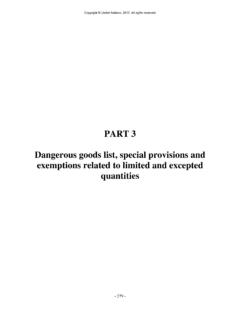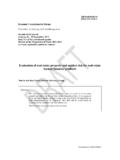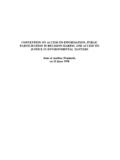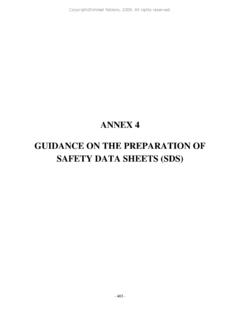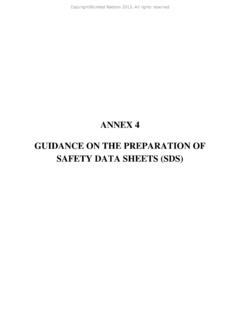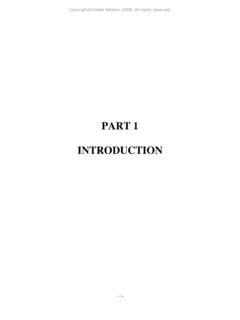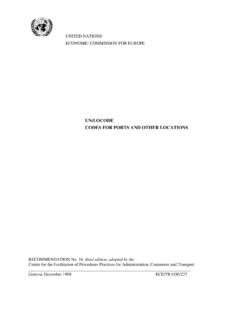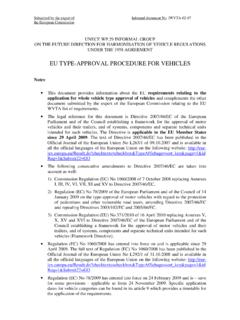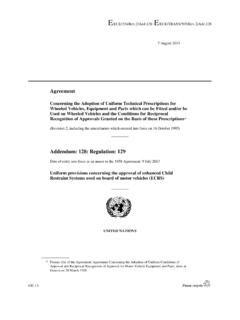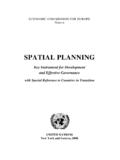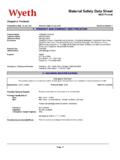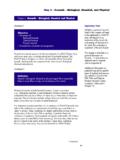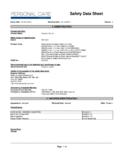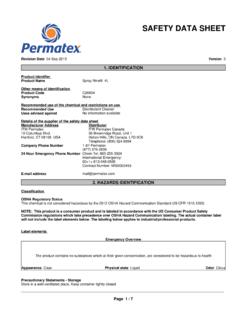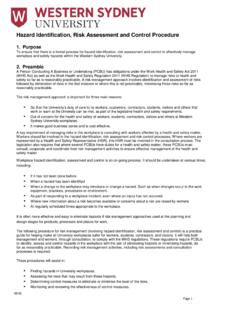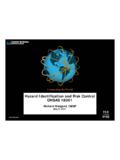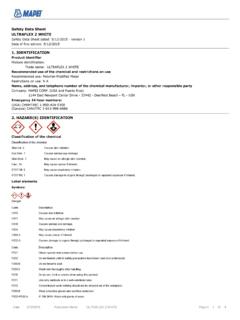Transcription of PART 2 PHYSICAL HAZARDS - UNECE Homepage
1 PART 2 physical hazards Copyright@United Nations, 2015. All rights reservedCopyright@United Nations, 2015. All rights reserved- 43 - CHAPTER EXPLOSIVES Definitions and general considerations An explosive substance (or mixture) is a solid or liquid substance (or mixture of substances) which is in itself capable by chemical reaction of producing gas at such a temperature and pressure and at such a speed as to cause damage to the surroundings. Pyrotechnic substances are included even when they do not evolve gases. A pyrotechnic substance (or mixture) is a substance or mixture of substances designed to produce an effect by heat, light, sound, gas or smoke or a combination of these as the result of non-detonative self-sustaining exothermic chemical reactions.
2 An explosive article is an article containing one or more explosive substances or mixtures. A pyrotechnic article is an article containing one or more pyrotechnic substances or mixtures. The class of explosives comprises: (a) Explosive substances and mixtures; (b) Explosive articles, except devices containing explosive substances or mixtures in such quantity or of such a character that their inadvertent or accidental ignition or initiation shall not cause any effect external to the device either by projection, fire, smoke, heat or loud noise; and (c) Substances, mixtures and articles not mentioned under (a) and (b) above which are manufactured with the view to producing a practical, explosive or pyrotechnic effect.
3 Classification criteria Substances, mixtures and articles of this class, which are not classified as an unstable explosive, are assigned to one of the following six divisions depending on the type of hazard they present: (a) Division : Substances, mixtures and articles which have a mass explosion hazard (a mass explosion is one which affects almost the entire quantity present virtually instantaneously); (b) Division : Substances, mixtures and articles which have a projection hazard but not a mass explosion hazard; (c) Division : Substances, mixtures and articles which have a fire hazard and either a minor blast hazard or a minor projection hazard or both, but not a mass explosion hazard: (i) combustion of which gives rise to considerable radiant heat; or (ii) which burn one after another, producing minor blast or projection effects or both; (d) Division : Substances, mixtures and articles which present no significant hazard: substances, mixtures and articles which present only a small hazard in the event of ignition or initiation.
4 The effects are largely confined to the package and no projection of fragments of appreciable size or range is to be expected. An external fire shall not cause virtually instantaneous explosion of almost the entire contents of the package; (e) Division : Very insensitive substances or mixtures which have a mass explosion hazard: substances and mixtures which have a mass explosion hazard but are so insensitive that there is very little probability of initiation or of transition from burning to detonation under normal conditions; - 43 -Copyright@United Nations, 2015. All rights reserved- 44 - (f) Division : Extremely insensitive articles which do not have a mass explosion hazard: articles which predominantly contain extremely insensitive substances or mixtures and which demonstrate a negligible probability of accidental initiation or propagation.
5 Explosives, which are not classified as an unstable explosive, are classified in one of the six divisions above based on Test Series 2 to 8 in Part I of the UN Recommendations on the Transport of Dangerous Goods, Manual of Tests and Criteria according to the following table: Table : Criteria for explosives Category Criteria Unstablea explosives or explosives of Division to For explosives of Divisions to , the following are the core set of tests that need to be performed: Explosibility: according to UN Test Series 2 (Section 12 of the UN Recommendations on the Transport of Dangerous Goods, Manual of Tests and Criteria).
6 Intentional explosivesb are not subject to UN Test Series 2. Sensitiveness: according to UN Test Series 3 (Section 13 of the UN Recommendations on the Transport of Dangerous Goods, Manual of Tests and Criteria). Thermal stability: according to UN Test 3(c) (Sub-section of the UN Recommendations on the Transport of Dangerous Goods, Manual of Tests and Criteria). Further tests are necessary to allocate the correct Division. a Unstable explosives are those which are thermally unstable and/or too sensitive for normal handling, transport and use. Special precautions are necessary. b This comprises substances, mixtures and articles which are manufactured with a view to producing a practical, explosive or pyrotechnic effect.
7 NOTE 1: Explosive substances or mixtures in packaged form and articles may be classified under divisions to and, for some regulatory purposes, are further subdivided into compatibility groups A to S to distinguish technical requirements (see UN Recommendations on the Transport of Dangerous Goods, Model Regulations, Chapter ). NOTE 2: Some explosive substances and mixtures are wetted with water or alcohols, diluted with other substances or dissolved or suspended in water or other liquid substances to suppress or reduce their explosives properties. They may be a candidate for classification as desensitized explosives (see Chapter ) or may be treated differently from explosive substances and mixtures (as desensitized explosives) for some regulatory purposes ( transport), see NOTE 3: For classification tests on solid substances or mixtures, the tests should be performed on the substance or mixture as presented.
8 If for example, for the purposes of supply or transport, the same chemical is to be presented in a PHYSICAL form different from that which was tested and which is considered likely to materially alter its performance in a classification test, the substance or mixture must also be tested in the new form. - 44 -Copyright@United Nations, 2015. All rights reserved- 45 - Hazard communication General and specific considerations concerning labelling requirements are provided in Hazard communication: Labelling (Chapter ). Annex 1 contains summary tables about classification and labelling. Annex 3 contains examples of precautionary statements and pictograms which can be used where allowed by the competent authority.
9 Table : Label elements for explosives Unstable Explosive Division Division Division Division Division Division Symbol Exploding bomb Exploding bomb Exploding bomb Exploding bomb Exploding bomb; or on orange backgrounda on orange backgrounda on orange backgrounda Signal word Danger Danger Danger Danger Warning Danger No signal word Hazard statement Unstable Explosive Explosive; mass explosion hazard Explosive; severe projection hazard Explosive; fire, blast or projection hazard. Fire or projection hazard May mass explode in fire No hazard statement a Applies to substances, mixtures and articles subject to some regulatory purposes ( transport).
10 NOTE 1: Unpackaged explosives or explosives repacked in packagings other than the original or similar packaging shall have the following label elements: (a) Symbol: exploding bomb; (b) Signal word: Danger ; and (c) Hazard statement: explosive; mass explosion hazard unless the hazard is shown to correspond to one of the hazard categories in table , in which case the corresponding symbol, signal word and/or the hazard statement shall be assigned. NOTE 2: Substances and mixtures, as supplied, with a positive result in Test Series 2 in Part I, Section 12, of the UN Recommendations on the Transport of Dangerous Goods, Manual of Tests and Criteria, which are exempted from classification as explosives (based on a negative result in Test Series 6 in Part I, Section 16 of the UN Recommendations on the Transport of Dangerous Goods, Manual of Tests and Criteria,) still have explosive properties.
